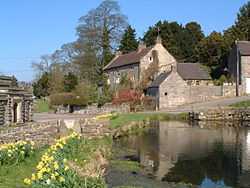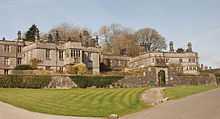Tissington
| Tissington | |
 Tissington Pond |
|
 Tissington |
|
| OS grid reference | SK176523 |
|---|---|
| District | Derbyshire Dales |
| Shire county | Derbyshire |
| Region | East Midlands |
| Country | England |
| Sovereign state | United Kingdom |
| Post town | DERBY |
| Postcode district | DE6 |
| Dialling code | 01335 |
| Police | Derbyshire |
| Fire | Derbyshire |
| Ambulance | East Midlands |
| EU Parliament | East Midlands |
| UK Parliament | West Derbyshire |
|
|
Coordinates: 53°04′N 1°44′W / 53.07°N 1.74°W
Tissington is a village in Derbyshire, England. It is part of the estate of Tissington Hall, owned by the FitzHerbert family since 1465. It is regarded as one of the most picturesque English villages and is a popular tourist attraction, particularly during its well dressing week. It also gives its name to the Tissington Trail, a 13-mile (21 km) walk and cycle path which passes nearby. The Limestone Way, another long-distance path and bridleway, passes through the village itself.
History
Tissington (Old English 'Tidsige's farm/settlement'[1]) is recorded in the Domesday Book of 1086 as 'Tizinctun',[2] having been given to Henry de Ferrers[3] by the King:
"In Tizinctun Ulchel, Edric, Ganel, Uluiet, Wictric, Leuric, Godwin had 4 carucates of land for geld. Land for 4 ploughs. Now in the demesne there (are) 3 ploughs: and 12 villanes, and 8 bordars having 4 ploughs, and 1 mill of 3 shillings (value); and 30 acres (120,000 m2) of meadow. Underwood 1-mile (1.6 km) in length and 4 furlongs in breadth. In the time of King Edward it was worth £4, now 40 shillings"[4]
During the reign of Henry I the estate passed to the Savage family. After the death of the last male heir, William le Savage in 1259 it was split between the families of the joint heiresses, the Meynells and Edensors. The Meynell's part of the estate was acquired in marriage by Nicholas FitzHerbert in the 1460s. During the reign of Elizabeth I, Francis, the great-grandson of Nicholas, purchased the remainder from the heirs of Edensors. From then the village and estate has been wholly in the ownership of the FitzHerbert family.[5]
Notable buildings


In the centre of the village is Tissington Hall, the seat of the FitzHerberts. A Jacobean building built in 1609[6] by Francis FitzHerbert, replacing an earlier moated manor house, it is a Grade II* listed building.
The parish church of St Mary opposite the hall has a Norman tower and font.
The majority of the other buildings in the village are built in the local vernacular style, of which around 70% are listed buildings.
Well dressings
An estimated fifty thousand[7] people visit the village to view its well dressings each year. Six wells (Children's Well, Coffin Well, Hall Well, Hands Well, Town Well and Yew Tree Well) are decorated during the week of Ascension Sunday with pictures formed by pressing flower petals and other organic materials into a clay substrate. The pictures are usually on a Biblical theme reflecting current events or anniversaries. This tradition is often cited to date back at least to 1348, following the village’s escape from the Black Death, which the villagers attributed to the purity of the water in its wells.[8]

Literary connections
Richard Graves wrote some of his novel The Spiritual Quixote whilst staying in Tissington.[9]
Notes
- ↑ English Place Names Society Database at the University of Nottingham
- ↑ Domesday Book: A Complete Translation. London: Penguin, 2003. ISBN 0-14-143994-7 p.1413
- ↑ Henry was given a large number of manors throughout England, but particularly in Derbyshire.
- ↑ Domesday Book: A Complete Translation. London: Penguin, 2003. ISBN 0-14-143994-7 p.745
- ↑ Buckley, D.H. (1966) A Short History of Tissington and its Parish Church
- ↑ Bygone Derbyshire site
- ↑ Figures from FizHerbert website
- ↑ Derbyshire-PeakDistrict website
- ↑ IGEW - Wilson, John Marius (1870) Imperial Gazetteer of England and Wales
External links
| Wikimedia Commons has media related to Tissington. |